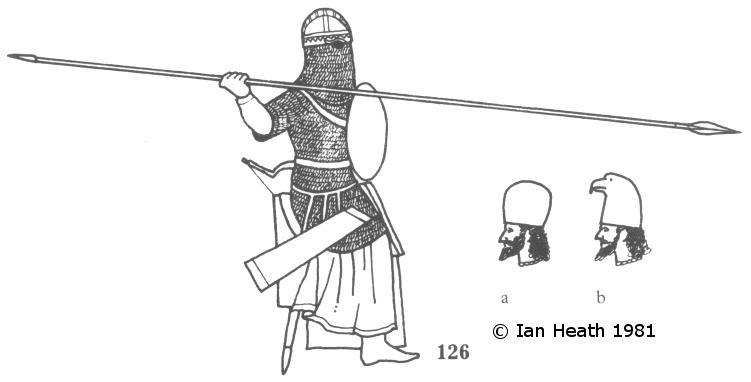SASSANID PERSIAN CLIBANARIIAn extract from The Armies and Enemies of Imperial Romeby Phil Barker & Ian Heath
125 & 126. SASSANID PERSIAN CLIBANARII | ||||||
SASSANID PERSIAN CLIBANARIIAn extract from The Armies and Enemies of Imperial Romeby Phil Barker & Ian Heath
125 & 126. SASSANID PERSIAN CLIBANARII | ||||||
125 is of an earlier period than the other clibanarius and is taken from the same monument as 83. He has a long sleeved mail coat supplemented by what may be a leather corslet, a surcoat or a defense of metal plates covered with fabric. A long straight sword and a bow case hang at his left and a quiver at his right. He has no shield and wields his 12 feet long Kontos with both hands. 125a shows how prominent men wore badges of rank. The long purple ribbons floating back from the helmet are the royal fillet, marking him as the king. The cloth balls at his helmet, shoulders and horse's head identify him as the 3rd century King Shapur, vanquisher of Valerian and victim of Odenathus. His horse is protected all round by a caparison of thick felt. Not every Sassanid knight of this period is shown on an armoured horse. Those that are have the felt dotted with rows of apparently metal badges, which in Shapur's case are a crescent over a circle, over a bar, and in the case of another figure, a disk over a bar. They are about 4 inches high. The resemblance to the tops of standards 128a and 128d are intriguing. The cut out for the horse's eyes is sometimes a rectangular slit right across the brow rather than separate holes.
126 is a later version. He wears a long robe beneath his mail, has a helmet with an attached mail hood with eye holes, has a small shield, and uses his Kontos overarm in one hand. The baggy trousers worn by 129 are an alternative lower garment. His horse has metal armour for its head, neck and chest only. This figure is in fact that of 7th century King Khusru II with his badges removed, but literary source show that such armour was almost certainly in use from the 4th century onwards. As well as the royal fillet, the king in this case had a small dome shaped crest on top of his helmet. Other types of helmet are known, including tall conical, the same with subsidiary points over the ears giving a three spire effect, and a type something between 131's cap and a modern forage cap. All have attached mail hoods. 126a and 126b may be helmets, but are more likely felt hats. 126a is the usual kind, 126b probably indicating that the wearer is a prominent noble called The Surenas.
